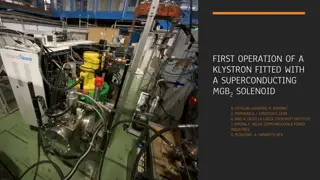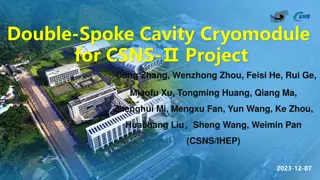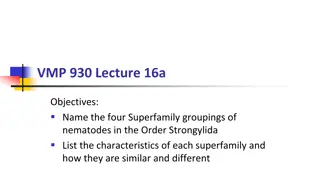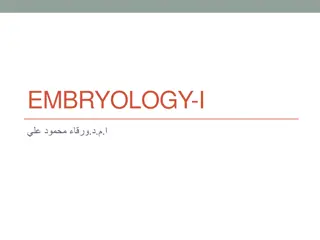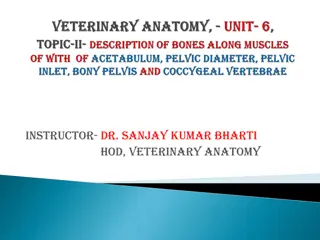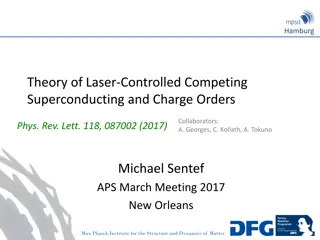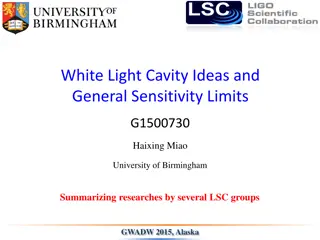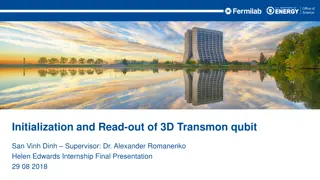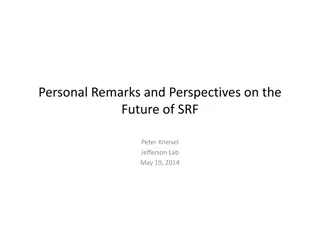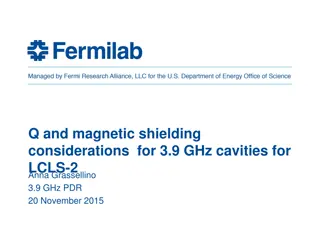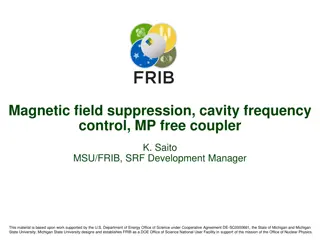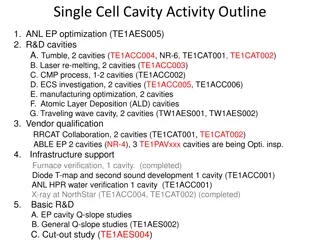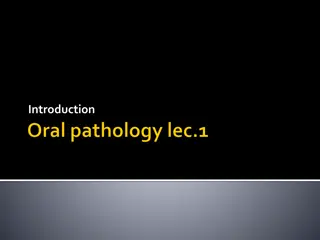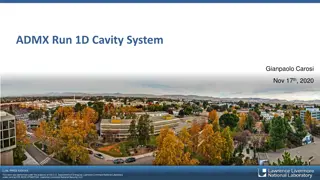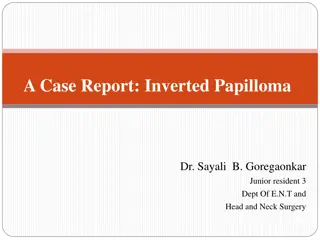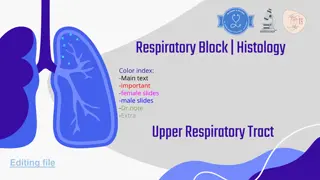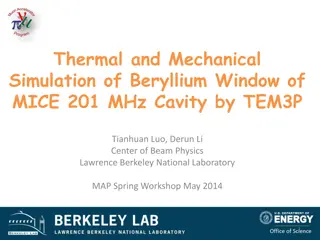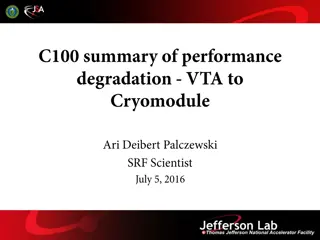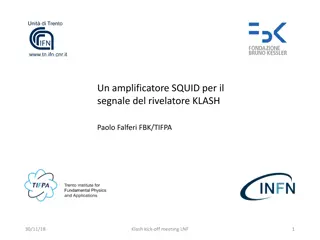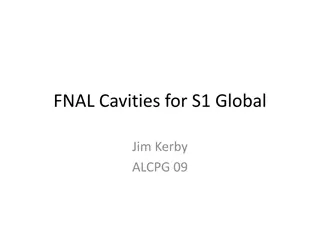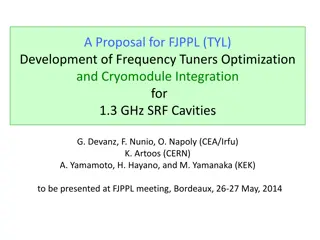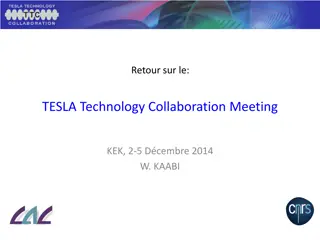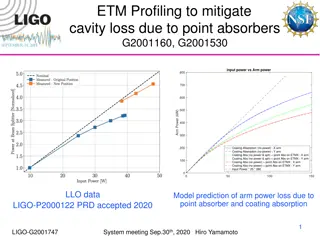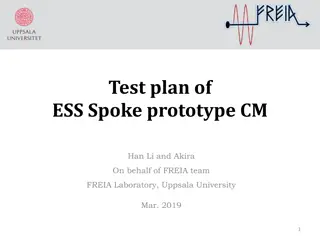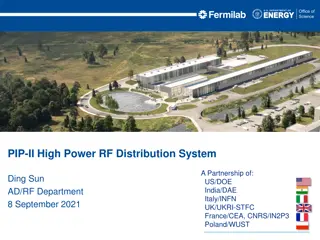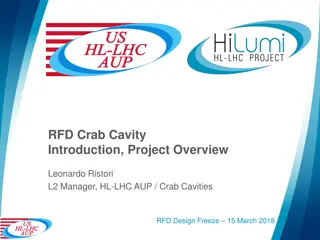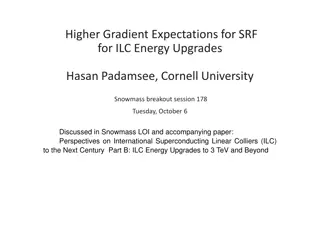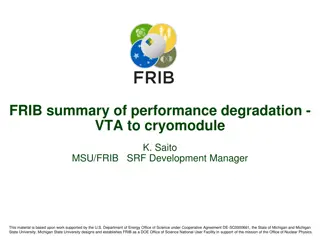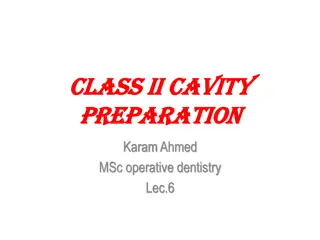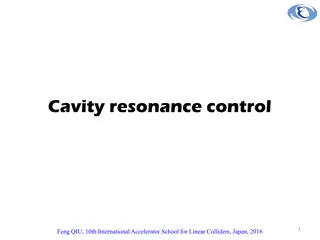FPC & HOM Technology Challenges, FCC
The challenges and technology involved in coupling beam power out of the cavity and coupling RF power into the cavity for the Future Circular Collider (FCC). It also covers the RF layout for the FCC-ee, basic parameters for proton and electron beams, accelerating RF in the LHC, input couplers, and p
0 views • 36 slides
Advanced Instrumentation and Diagnostics for Superconducting Magnets at CERN
Explore the crucial needs for instrumentation and diagnostics at CERN, focusing on superconducting magnets. Topics include voltage and strain measurements, vibration analysis, temperature sensing, quench detection, and magnet form factor considerations. The importance of advanced diagnostics and com
1 views • 23 slides
Advancements in Superconducting Solenoid Technology for Klystrons at CERN
Research highlights the first operation of a klystron equipped with a superconducting MgB2 solenoid, aiming to enhance efficiency and sustainability of klystron systems. The focus is on integrating novel solenoid designs, such as those proposed by A. Yamamoto, to optimize klystron performance at CER
5 views • 18 slides
Advanced Cryomodule Technology for China's Spallation Neutron Source Upgrade
This article discusses the development of a Double-Spoke Cavity Cryomodule for the China Spallation Neutron Source (CSNS) project. It covers the structure of the cryomodule, integration processes, future work, and details about the CSNS beam parameters and upgrade scheme. The content includes images
0 views • 19 slides
Innovative Superconducting Cavities Research Project Overview
This project, funded by the European Union's Horizon 2020 program, focuses on innovative superconducting cavities coated with superconducting films. Objectives include optimizing production procedures, testing prototypes, and reducing costs. Tasks involve coordination, strategy development, and achi
2 views • 9 slides
Overview of Superfamilies in Order Strongylida Nematodes
The Order Strongylida in nematodes encompasses four main superfamilies - Trichostrongyloidea, Strongyloidea, Ancylostomoidea, and Metastrongyloidea. Each superfamily is defined by distinct characteristics such as buccal cavity size and location within the host, as well as differences in life cycle a
1 views • 34 slides
Development of Human Face and Oral Cavity in Embryology
The process of embryonic development involves the formation of the human face and oral cavity from the morula stage onwards. Key structures such as the primitive streak play a vital role in establishing bilateral symmetry, initiating germ layer formation, and guiding gastrulation. The differentiatio
2 views • 32 slides
Veterinary Anatomy Overview: Pelvic Cavity and Bony Pelvis Structures
The instructor, Dr. Sanjay Kumar Bharti, explains the acetabulum, obturator foramen, sexual differences, and characteristics of sheep and goats related to pelvic anatomy. Details include the structure of the acetabulum, the large obturator foramen, pelvic cavity, and differences between male and fem
2 views • 18 slides
Laser-Controlled Competing Superconducting and Charge Orders in Transition Metal Dichalcogenides
Hamburg Theory of laser-controlled competing superconducting and charge orders explores the use of lasers to manipulate the ordering mechanisms in transition metal dichalcogenides, leading to ultrafast switching and the induction of new states of matter. This research delves into generic mechanisms
0 views • 13 slides
Advances in White Light Cavity for Sensitivity and Bandwidth Optimization
The research discusses innovative ideas for enhancing sensitivity and bandwidth limits in the context of white light cavity technologies. It explores methods such as external/internal squeezing and signal recycling to surpass existing Mizuno Limits, shedding light on crucial issues for future upgrad
0 views • 27 slides
Exploring 3D Transmon Qubits in Quantum Computing
This document delves into the initialization, read-out, and measurement techniques of 3D transmon qubits as integral components of quantum computing. It covers the underlying principles of superconducting qubits, SRF cavity utilization, and the roadmap for improving quantum memory and coherence time
0 views • 12 slides
Insights on the Future of SRF Technology by Peter Kneisel at Jefferson Lab
Peter Kneisel reflects on the past and present advancements in superconducting radiofrequency (SRF) technology, debunking the notion that Niobium has reached its limit. He discusses ongoing improvements in SRF cavities, surface treatments, and fabrication techniques, highlighting the need for cost r
1 views • 20 slides
Magnetization, Decay, and Error Fields in HTS Accelerator Magnets
The research conducted at The Ohio State University focuses on understanding the magnetization, decay, and influence of error fields in high-temperature superconducting (HTS) accelerator magnets. The study explores the impact of different superconducting materials such as Nb3Sn, YBCO, and Bi:2212 on
0 views • 21 slides
Understanding the Connection Between Oral Health and Systemic Diseases
The relationship between oral health and systemic diseases is significant, with manifestations within the oral cavity providing clues to underlying systemic issues. Disease processes involve aspects like etiology, pathogenesis, morphologic changes, and clinical significance. Organisms and toxins spr
0 views • 19 slides
Understanding Magnetic Shielding Considerations for 3.9 GHz Cavities
This document discusses Q and magnetic shielding considerations for 3.9 GHz cavities used in the LCLS-II project, highlighting the unique behavior observed in nitrogen-treated cavities. The study delves into the improved Q values and field dependence of quality factors, challenging traditional niobi
0 views • 10 slides
Magnetic Field Suppression and Cavity Frequency Control in SRF Development at FRIB
This material discusses the techniques used at the Facility for Rare Isotope Beams (FRIB) to suppress magnetic fields and control cavity frequencies. It covers topics such as remnant field suppression, solenoid package design, validation tests, and magnetic shield material validation for the FRIB cr
0 views • 14 slides
Single Cell Cavity Activity Overview
The Single Cell Cavity Activity includes ANL EP optimization, R&D cavities for various processes such as tumble, laser re-melting, CMP, ECS investigation, and manufacturing optimization. There are also activities related to Atomic Layer Deposition (ALD) cavities, traveling wave cavities, vendor qual
0 views • 4 slides
Understanding the Anatomy of the Oral Cavity
The oral cavity extends from the lips to the hard and soft palate and houses various structures like the tongue, buccal mucosa, floor of the mouth, hard palate, gingiva, and lips. This detailed overview covers the different regions of the tongue, mucosal linings, salivary glands, and palatal structu
0 views • 27 slides
Key Upgrades for Cavity 1D in ADMX Experiment
The ADMX experiment at LLNL is undergoing key upgrades for Cavity 1D to enhance axion-to-photon conversion power. The upgrades aim to optimize frequency coverage, form-factor, and Q-factor, with a focus on improving physical and noise temperature. Replacing stainless steel with carbon fiber support
0 views • 11 slides
Long-term Operation of Superconducting Triplet Quadrupoles (STQ) with Cryocoolers at RIKEN
Introduction to the operational experiences, maintenance, and long-term operation of the Superconducting Triplet Quadrupoles (STQ) with cryocoolers for the BigRIPS In-flight Separator at RIKEN. Details include standard operation of SC magnets, unique features of BigRIPS and RI-beam delivery lines, S
0 views • 16 slides
Anatomy and Physiology of the Throat: A Comprehensive Overview
The throat, comprising the mouth, pharynx, and associated structures, plays vital roles in digestion, communication, and breathing. Understanding the anatomy and physiology of the throat, from the oral cavity to the laryngopharynx, helps in comprehending functions like swallowing, sound production,
0 views • 15 slides
Inverted Papilloma Case Report and Diagnosis
A 62-year-old male presented with a mass in the right nasal cavity causing obstruction and headache. No history of URTI or allergies. Local examination revealed a pinkish mass with possible differential diagnosis of Antrochoanal Polyp, Ethmoidal polyposis, or Inverted Papilloma. Nasal endoscopy show
0 views • 24 slides
Understanding Microbial Ecology in the Oral Cavity
The oral cavity is a unique ecological system that plays host to a diverse resident microflora, consisting of various bacterial species, yeasts, and other microorganisms. This dynamic microbial community interacts with the human body, contributing to its normal development and defense systems. The c
0 views • 36 slides
Understanding Nasal Cavity Histology and Respiratory Structures
The detailed information provided covers the histological structures of the nasal cavity, including the vestibule, respiratory mucosa, nasal septum, olfactory mucosa, and paranasal sinuses. It also delves into the microscopic structures of the wall of the trachea and primary bronchi. The respiratory
0 views • 11 slides
Understanding the Anatomy of Lungs
The lungs, vital organs of the respiratory system, consist of two cone-shaped structures with apex, base, costal, and medial surfaces. Positioned in the thoracic cavity, they are associated with the heart, great vessels, and other structures in the mediastinum. The right lung has three lobes, while
0 views • 16 slides
Thermal and Mechanical Simulation of Beryllium Window for MICE 201 MHz Cavity
Conducted thermal and mechanical simulations using TEM3P for the beryllium window of the MICE 201 MHz cavity. Analysis focused on temperature distribution, frequency shifts, thermal deformation control, and stress considerations under varying operation conditions and material properties. Detailed in
0 views • 11 slides
Quality Control and Testing Procedures for Superconducting Radiofrequency Cavities
The presentation highlights the rigorous processes involved in qualifying superconducting radiofrequency (SRF) cavities for high-performance applications. Each cavity undergoes a detailed qualification process, including BCP treatment, electropolishing, and high-pressure rinsing, to ensure optimal p
0 views • 18 slides
Understanding the Superconducting Quantum Interference Device (SQUID)
The Superconducting Quantum Interference Device (SQUID) is a crucial component for detecting signals in devices like the KLASH detector. By combining Flux Quantization and Josephson Tunneling, the SQUID operates based on key principles such as the Josephson Equations and the Flux Quantum. Through ca
0 views • 23 slides
FNAL Global S1 Cavity Plan and Shipment Details
The content discusses the progress and plans related to FNAL Cavities for the S1 Global project. It covers topics such as major components, cavity processing challenges, the developed working plan, and details of cavity shipment to KEK. Various images of cavity plans and processing are included alon
0 views • 17 slides
Development of Frequency Tuners Optimization for SRF Cavities
Frequency tuners are crucial for adjusting the fundamental frequency of superconducting RF cavities to counteract detuning effects. The proposal discusses the importance of tuners, their operational mechanisms, and the challenges in achieving high reliability for efficient cavity operation. Various
0 views • 14 slides
TESLA Technology Collaboration Meeting at KEK December 2014
The TESLA Technology Collaboration (TTC) aims to promote R&D in RF superconducting technologies through collaborative meetings to address technical challenges and share developments. The recent meeting at KEK in December 2014 covered working groups on module tests, assembly, high Q0, cavity fabricat
0 views • 15 slides
ETM Profiling for Cavity Loss Mitigation Due to Absorbers
The ETM profiling aims to mitigate cavity loss caused by point absorbers through input power analysis versus arm power. The study includes data on coating absorption, arm power loss predictions, and optimization strategies such as polishing and mirror surface design. The effect of new coatings is co
0 views • 48 slides
Test Plan for ESS Spoke Prototype CM at FREIA Laboratory, Uppsala University
This test plan outlines the detailed schedule and tasks for testing the ESS (European Spallation Source) Spoke prototype CM conducted by Han Li and Akira on behalf of the FREIA team at FREIA Laboratory, Uppsala University. The plan includes activities such as warm-up, cool-down, cavity conditioning,
0 views • 11 slides
PIP-II High Power RF Distribution System Overview
The PIP-II High Power RF Distribution System is a collaborative project involving various countries and institutions to develop a sophisticated system capable of efficiently distributing RF power to superconducting cavities. The system consists of multiple distribution lines and components designed
0 views • 28 slides
Design Freeze for RFD Crab Cavity Project
The RFD Crab Cavity Project, overseen by Leonardo Ristori, has undergone significant design modifications to meet HL-LHC requirements. The finalized design includes dressed RFD crab cavities aimed for qualification and integration by 2023. Upcoming reviews and approvals are crucial as per the projec
0 views • 10 slides
CEPC RF Power Source Overview
The CEPC RF Power Source involves high-power RF sources for accelerating and stabilizing particles in the Collider system. It includes design elements, efficiency considerations, and operational cost impacts. The transmission system utilizes superconducting cavity technology to meet power demands ef
0 views • 24 slides
Advancements in Superconducting Linear Colliders for ILC Energy Upgrades
Discussion on higher gradient expectations for SRF at the International Linear Collider (ILC) for energy upgrades beyond 3 TeV, highlighting advancements in single and multi-cell cavity gradients over three decades. Promising R&D paths include cold electropolishing, nitrogen infusion, advanced cavit
0 views • 15 slides
Performance Degradation Summary for FRIB Cryomodule VT vs. Bunker
FRIB's performance degradation analysis focuses on validating the design of the cryomodule, with tests conducted under various operational conditions to assess parameters such as cryogenic losses, SRF subsystems performance, and cavity dynamics. The ReA6-1 cavity's performance, measured in terms of
0 views • 5 slides
Class II Cavity Preparation in Operative Dentistry
Class II cavity preparation in operative dentistry involves several key steps like occlusal outline form, proximal outline form, and resistance form. It aims to remove caries and faults while conserving tooth structure and providing sufficient support for restorative material like amalgam. Proper ou
0 views • 19 slides
Cavity Resonance Control in Linear Colliders: An Overview
Feng QIU discusses cavity resonance control techniques for Linear Colliders in this presentation. Topics include cavity voltage, phase, piezoelectric control, and stabilization of the RF field to optimize performance. The content emphasizes the importance of managing cavity resonances effectively to
0 views • 21 slides


